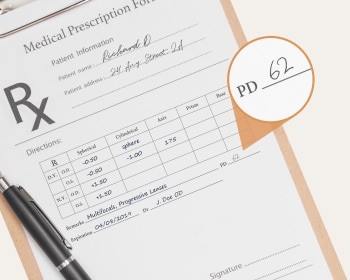Pupillary Distance (PD) is the distance between the centers of your pupils, and at WHAT.EDU.VN, we’re here to explain why it matters for your eyewear. Understanding PD ensures your glasses provide optimal vision correction and comfort. Let’s explore this measurement, its significance, and how you can easily obtain it for your next glasses purchase, including interpupillary distance, accurate measurement, and optical correction.
1. What Is Pupillary Distance (PD)?
Pupillary Distance (PD) is the measurement in millimeters between the center of one pupil to the center of the other pupil. This measurement is crucial when fitting eyeglasses because it ensures the lenses are positioned correctly in front of your eyes. According to the American Academy of Ophthalmology, accurate PD measurement is essential for optimal vision correction and comfort.
1.1 Why Is PD Important for Eyeglasses?
Having the correct PD is essential because it ensures that you are looking through the optimal point on your lenses. When the PD is inaccurate, it can cause:
- Eye strain
- Headaches
- Blurred vision
- Distortion
1.2 What Are the Different Types of PD?
There are two main types of PD:
- Distance PD: This is the measurement taken when you are focusing on a distant object. It is used for single-vision glasses that correct distance vision.
- Near PD: This is the measurement taken when you are focusing on a close object. It is used for reading glasses, bifocals, and progressive lenses.
Understanding these distinctions ensures that your eyewear caters specifically to your visual needs, whether for distance or near tasks.
2. How to Measure Your Pupillary Distance (PD) at Home
If your PD isn’t included in your prescription, don’t worry; measuring it at home is simple. You can use a PD ruler and a mirror or ask a friend for assistance. Below are two methods to measure your PD at home:
2.1 Measuring PD with a Mirror
- Obtain a PD Ruler: You can print a PD ruler from various websites or use a standard millimeter ruler.
- Stand in Front of a Mirror: Position yourself about 8 inches away from the mirror.
- Hold the Ruler: Hold the ruler horizontally across your brow, ensuring the millimeter side is facing you.
- Align the Ruler: Close your right eye and align the zero mark of the ruler with the center of your left pupil.
- Read the Measurement: Open your right eye and close your left eye. The millimeter mark that aligns with the center of your right pupil is your PD.
- Repeat: Repeat this process a few times to ensure accuracy and take an average of the measurements.
2.2 Measuring PD with a Friend
- Have Your Friend Sit Down: Ensure your friend is sitting comfortably and looking straight ahead.
- Position Yourself: Stand in front of your friend, facing them directly.
- Hold the Ruler: Hold the PD ruler horizontally across their brow.
- Align the Ruler: Align the zero mark with the center of their right pupil while they focus on an object about 10-20 feet away.
- Read the Measurement: The millimeter mark that aligns with the center of their left pupil is their PD.
- Repeat: Repeat this process a few times to ensure accuracy.
2.3 What Tools Do You Need?
To measure your PD at home, you will need:
- A PD ruler (printable or physical)
- A mirror or a friend
- Good lighting
2.4 Tips for Accurate Measurement
To ensure an accurate PD measurement, keep the following tips in mind:
- Keep your head still
- Focus on a distant object
- Repeat the measurement multiple times
- Ensure good lighting
3. What Is the Average Pupillary Distance?
The average PD varies between men and women. Knowing the average PD can give you a general idea of what to expect, but it’s always best to have an accurate measurement for the best vision correction.
3.1 Average PD for Women
The average PD for women is around 60 mm. According to a study by the College of Optometrists, the range typically falls between 58 mm and 62 mm.
3.2 Average PD for Men
The average PD for men is around 64 mm. Research indicates that the PD range for men is generally between 62 mm and 66 mm.
3.3 PD Range for Children
Children’s PD is typically smaller than adults and varies widely depending on age. The average PD for children ranges from 43 mm to 58 mm. Here is a table illustrating typical PD ranges for different age groups:
| Age Group | Average PD (mm) |
|---|---|
| 3-5 years | 49 – 52 |
| 6-10 years | 52 – 55 |
| 11-15 years | 55 – 58 |


This table provides a helpful guide, but individual measurements can vary.
4. Single PD vs. Dual PD: What’s the Difference?
Understanding the difference between single and dual PD is important for ensuring your glasses fit correctly and provide optimal vision correction.
4.1 Single PD Explained
Single PD is the measurement between the center of one pupil to the center of the other pupil, expressed as one number. For example, if the distance between your pupils is 62 mm, your single PD is 62 mm.
4.2 Dual PD Explained
Dual PD, also known as monocular PD, measures the distance from the center of each pupil to the midline of the nose. This is expressed as two numbers, one for each eye. For instance, your dual PD might be 31 mm for the right eye and 30 mm for the left eye.
4.3 Why Use Dual PD?
Dual PD is particularly useful for individuals who have a significant difference in the position of their eyes relative to the center of their face. It provides a more precise lens placement, which can improve visual comfort and reduce eye strain.
5. How PD Affects Your Vision
The accuracy of your pupillary distance (PD) plays a critical role in how well your eyeglasses correct your vision. An incorrect PD can lead to a range of visual discomforts and inefficiencies.
5.1 Impact on Lens Placement
When your PD is accurately measured, the optical center of each lens aligns directly with your pupils. This alignment ensures that you are looking through the intended sweet spot of the lens, providing the clearest vision possible. Conversely, if the PD is off, the optical center is misaligned, forcing your eyes to work harder to compensate.
5.2 Common Issues with Incorrect PD
- Eye Strain: Misaligned lenses can cause your eye muscles to strain as they try to focus through the wrong part of the lens.
- Headaches: The constant strain on your eye muscles can lead to frequent headaches, especially after prolonged use of eyeglasses.
- Blurred Vision: An incorrect PD can result in blurred or distorted vision, making it difficult to see clearly at various distances.
- Dizziness and Nausea: In some cases, severe misalignment can cause dizziness and nausea due to the disorientation from distorted vision.
5.3 Correcting Vision Problems
Ensuring your eyeglasses have the correct PD is essential for correcting various vision problems, including:
- Myopia (Nearsightedness): Proper lens alignment helps focus light correctly on the retina for clear distance vision.
- Hyperopia (Farsightedness): Accurate PD ensures the lenses assist the eyes in focusing on close objects without strain.
- Astigmatism: Correct PD is crucial for aligning the cylindrical correction of astigmatism lenses.
- Presbyopia: For those requiring reading glasses or multifocal lenses, precise PD is essential for comfortable and effective near vision.
5.4 The Role of an Eye Care Professional
While it’s possible to measure your PD at home, consulting an eye care professional is always recommended. They use precise instruments and techniques to obtain the most accurate measurement, ensuring your eyeglasses provide the best possible vision correction and comfort.
6. Finding Your PD on Your Prescription
Your pupillary distance (PD) may be included on your eyeglass prescription. Knowing how to find it can save you time when ordering glasses online.
6.1 Where to Look
PD is usually listed as a single number, such as 62, representing the total distance between your pupils. In some cases, it may be listed as two numbers, such as 31/31, indicating the distance from the center of each pupil to the bridge of your nose. This is known as monocular or dual PD.
6.2 Common Abbreviations
Some common abbreviations you might see on your prescription include:
- PD: Pupillary Distance
- OD: Right eye (Oculus Dexter)
- OS: Left eye (Oculus Sinister)
- OU: Both eyes (Oculus Uterque)
6.3 What If PD Is Missing?
If your PD is not included on your prescription, you can:
- Contact Your Eye Doctor: The easiest way to obtain your PD is to call the office where you had your eye exam and ask them to provide it.
- Measure It Yourself: Use one of the methods described earlier in this article to measure your PD at home.
- Have It Measured at an Optical Store: Visit a local optical store and ask them to measure your PD.
6.4 Example Prescriptions
Here are a few examples of how PD might be listed on your prescription:
-
Example 1: Single PD
- OD: -1.50
- OS: -2.00
- PD: 62
-
Example 2: Dual PD
- OD: -1.50
- OS: -2.00
- PD: 31/31
-
Example 3: Complete Prescription
- OD: -1.50 Sph, -0.50 Cyl, 90 Axis
- OS: -2.00 Sph, -0.25 Cyl, 180 Axis
- PD: 62
7. Ordering Glasses Online: Why PD Matters
When ordering glasses online, providing an accurate PD is crucial for ensuring your new glasses provide clear and comfortable vision. Many online retailers, like Eyebuydirect, allow you to enter your PD during the ordering process.
7.1 How to Enter Your PD Online
- Find the PD Field: During the checkout process, look for a field labeled “Pupillary Distance” or “PD.”
- Enter Your PD: Enter your PD measurement in millimeters. If you have a dual PD, enter both numbers separated by a slash (e.g., 31/31).
- Double-Check: Ensure you have entered the correct numbers before submitting your order.
7.2 What Happens If PD Is Incorrect?
If you provide an incorrect PD when ordering glasses online, you may experience:
- Eye strain
- Headaches
- Blurred vision
- Distortion
In such cases, you may need to return the glasses and have them remade with the correct PD.
7.3 Benefits of Ordering Glasses Online
Ordering glasses online offers several advantages, including:
- Convenience: Shop from the comfort of your own home.
- Cost Savings: Online retailers often offer lower prices than traditional brick-and-mortar stores.
- Wide Selection: Access a vast selection of frames and lens options.
7.4 Reputable Online Retailers
Some reputable online retailers for eyeglasses include:
- Eyebuydirect
- Warby Parker
- Zenni Optical
8. Common Mistakes in Measuring Pupillary Distance
Measuring pupillary distance (PD) accurately is essential for ensuring your glasses provide the best possible vision correction. However, several common mistakes can lead to inaccurate measurements.
8.1 Not Using the Correct Tools
Using a standard ruler instead of a PD ruler can result in inaccurate measurements. PD rulers are specifically designed with millimeter markings that allow for precise measurements.
8.2 Incorrect Positioning
Positioning the ruler incorrectly is another common mistake. The ruler should be held horizontally across the brow, with the millimeter side facing you.
8.3 Not Focusing on a Distant Object
When measuring PD, it’s important to focus on a distant object to ensure your eyes are properly aligned. Focusing on a close object can cause your eyes to converge, leading to an inaccurate measurement.
8.4 Measuring Alone Incorrectly
Measuring your PD alone can be challenging, especially if you are using a mirror. It’s easy to misalign the ruler or move your head, resulting in an inaccurate measurement.
8.5 Not Repeating the Measurement
Failing to repeat the measurement multiple times can also lead to inaccuracies. Repeating the measurement and taking an average can help ensure a more precise result.
8.6 Measuring Children’s PD
Measuring PD in children can be particularly challenging due to their tendency to move around. Patience and gentle guidance are essential for obtaining an accurate measurement.
8.7 Using Old PD Measurements
Your PD can change over time, especially in children. Using an old PD measurement can result in glasses that no longer provide optimal vision correction.
8.8 Forgetting Near PD
If you need progressive or bifocal lenses, you’ll also need to measure your near PD. Forgetting this measurement can result in glasses that are not properly aligned for reading and close-up work.
9. FAQ About Pupillary Distance
| Question | Answer |
|---|---|
| What is the average PD for adults? | The average PD for adults ranges from 54 mm to 74 mm. Women typically have an average PD of around 60 mm, while men average around 64 mm. |
| Can my PD change over time? | Yes, especially in children. It’s recommended to have your PD measured regularly, particularly when getting new glasses. |
| Is it safe to measure my PD at home? | Yes, measuring your PD at home is generally safe, provided you follow the instructions carefully and use the correct tools. |
| What if I have different PD measurements? | If you obtain different PD measurements, take an average of the measurements to get the most accurate result. |
| What does PD stand for? | PD stands for Pupillary Distance. |
| Is PD the same as interpupillary distance? | Yes, PD and interpupillary distance (IPD) are the same thing. Both terms refer to the distance between the centers of your pupils. |
| What if my prescription doesn’t include PD? | You can request it from your eye doctor, measure it yourself, or have it measured at an optical store. |
| How important is an accurate PD? | An accurate PD is crucial for ensuring your glasses provide the best possible vision correction and comfort. |
| Can I use the same PD for contacts and glasses? | No, the PD for contact lenses and eyeglasses is measured differently and is not interchangeable. |
| What is monocular PD? | Monocular PD refers to the distance from the center of each pupil to the midline of the nose. It’s measured separately for each eye. |
10. Need Help? Ask WHAT.EDU.VN!
Measuring your pupillary distance (PD) accurately is essential for ensuring your eyeglasses provide optimal vision correction and comfort. Whether you choose to measure it yourself or have it done professionally, an accurate PD will help you see clearly and comfortably.
If you have any questions or need further assistance, don’t hesitate to reach out to us at WHAT.EDU.VN. We offer a free question-and-answer platform where you can get expert advice on all your eye care needs. Contact us at:
- Address: 888 Question City Plaza, Seattle, WA 98101, United States
- WhatsApp: +1 (206) 555-7890
- Website: WHAT.EDU.VN
At WHAT.EDU.VN, we understand the challenges of finding reliable information quickly and affordably. That’s why we’ve created a platform where you can ask any question and receive prompt, accurate answers from knowledgeable individuals. Don’t struggle with uncertainty; let us help you find the answers you need. Visit what.edu.vn today and ask your question for free!

